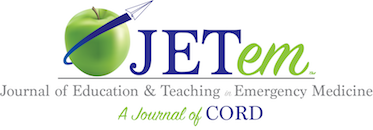Curriculum
A Longitudinal, Practical Curriculum for Faculty Development as New Coaches in Graduate Medical Education
DOI: https://doi.org/10.21980/J88M08The aim of this curriculum is to provide a longitudinal, practical, and interactive coach training curriculum for faculty with no prior coaching experience.
A Novel Leadership Curriculum for Emergency Medicine Residents
DOI: https://doi.org/10.21980/J81D2SThe goals of this curriculum are to expose Emergency Medicine residents to the basics of leadership, to provide a graduated series of interactive, psychologically safe environments to explore individual leadership styles, to review interesting relevant literature, and to discuss leadership principles and experiences with senior leaders in our Emergency Department.
What You Didn’t Learn in Residency: A Collective Curriculum for New Academic EM Faculty and Fellows
DOI: https://doi.org/10.21980/J8WP9ZThe aim of this curriculum is to develop relevant skills to promote academic success for fellows and first-year faculty at the start of their academic career and which could be completed during a one-year training timeline. We included topics relevant to all fellow and new faculty’s expected personal and professional journey during this first year, including time management, academic productivity, resilience/wellness, and developing a national reputation.
E-FAST Ultrasound Training Curriculum for Prehospital Emergency Medical Service (EMS) Clinicians
DOI: https://doi.org/10.21980/J8S060By the end of these training activities, prehospital EMS learners will be able to demonstrate foundational ultrasound skills in scanning, interpretation, and artifact recognition by identifying pertinent organs and anatomically relevant structures for an E-FAST examination. Learners will differentiate between normal and pathologic E-FAST ultrasound images by identifying the presence of free fluid and lung sliding. Learners will also explain the clinical significance and application of detecting free fluid during an E-FAST scan.
Management of Poisoned Patients: Implementing a Blended Toxicology Curriculum for Emergency Medicine Residents
DOI: https://doi.org/10.21980/J8C937The goal of this curriculum is to introduce EM residents to core toxicology concepts and to reinforce toxicology principles through a multimodal approach that leads to increased confidence in the management of poisoned patients on shift.
Implementation of a Medical Education Rotation for Senior Emergency Medicine Residents
DOI: https://doi.org/10.21980/J8BH17Our objectives were to provide our senior residents with exposure to various aspects of the field of MedEd, to further develop their teaching skills and to encourage them to consider a career in academic emergency medicine.
Emergency Medicine Curriculum Utilizing the Flipped Classroom Method: Pulmonary Emergencies
DOI: https://doi.org/10.21980/J8F646The educational strategies used in this curriculum include small group case-based modules authored by education faculty and content experts based on the core emergency medicine content outlined in the ABEM Model EM curriculum. The Socratic method, used during small group sessions, encourages active participation; small groups also focus on the synthesis and application of knowledge through the discussion of clinical experiences. The use of free open access medical education (FOAM) resources allows learners to work at their own pace and maximize autonomy. Learners are encouraged to use such resources for preparation prior to small group sessions, and also to review and help solidify important points after the conclusion of in-person discussions.
Novel Emergency Medicine Curriculum Utilizing Self-Directed Learning and the Flipped Classroom Method: Neurologic Emergencies Small Group Module
DOI: https://doi.org/10.21980/J89H0JWe aim to teach the presentation and management of cardiovascular emergencies through the creation of a flipped classroom design. This unique, innovative curriculum utilizes resources chosen by education faculty and resident learners, study questions, real-life experiences, and small group discussions in place of traditional lectures. In doing so, a goal of the curriculum is to encourage self-directed learning, improve understanding and knowledge retention, and improve the educational experience of our residents.
Resuscitation Rotation: A Novel Emergency Medicine Rotation to Augment Resuscitative Training
DOI: https://doi.org/10.21980/J85P9FOur goal is to augment resuscitative education in the ED in order to improve resident skill, confidence, and knowledge of resuscitative treatments.
A Simulation-Based Course for Prehospital Providers in a Developing Emergency Medical Response System
DOI: https://doi.org/10.21980/J82053This curriculum presents a refresher course in recognizing and stabilizing an acutely ill patient for prehospital providers practicing in a low/middle-income developing EMS system.
1›
Page 1 of 2
